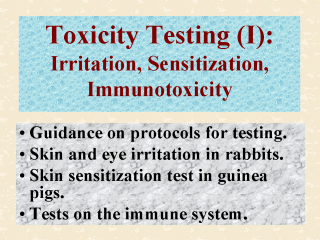| front |1 |2 |3 |4 |5 |6 |7 |8 |9 |10 |11 |12 |13 |14 |15 |16 |17 |18 |19 |20 |21 |22 |23 |24 |25 |review |
 |
The U.S. EPA,
the U.S. FDA, and the international OECD (Organization for Economic Cooperation and
Development; see Slide 21) have written good laboratory practice standards which
are expected to be followed when toxicity tests are carried out in support of the
marketing of a chemical or a product. These regulatory agencies and others have also
provided guidance for the conduct of various types of toxicity studies. The protocol
provisions from regulatory guidelines for the various types of toxicity testing are
highlighted in several chapters in Hayes (1994), and will be further discussed in Slide
21. In general, the chemicalís ability to irritate the skin and eye after an acute exposure (less than a day) is tested in rabbits. Guinea pigs are the preferred species used in the skin sensitization test. These guinea pigs will be given multiple dose administrations over a period of 2 to 4 weeks first and then after another 2 to 3 weeks later, a nonirritating dose for challenge of sensitization. The immune system includes the thymus, lymph nodes, bone marrow, lymphocytes (T and B cells), immunoglobulins, etc. Immunotoxicity studies are those in which the cellular, humoral, and other toxic effects on this system are investigated. Tests of the immune system involve (Hodgson et al., 1998): (1) the weight and morphology of the lymphoid organs; (2) the capacity to respond to challenges; and (3) specific in vitro examinations of components of the immune system. Skin tests for antibody-mediated responses and for delayed hypersensitivity are used to assess overall immunocompetance. |